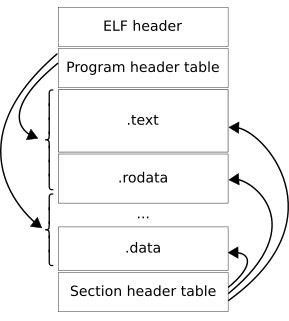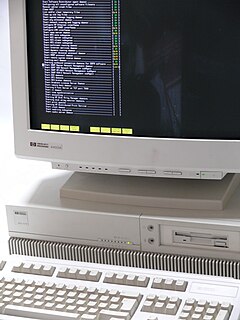Related Research Articles

The Common Desktop Environment (CDE) is a desktop environment for Unix and OpenVMS, based on the Motif widget toolkit. It was part of the UNIX 98 Workstation Product Standard, and was for a long time the Unix desktop associated with commercial Unix workstations.

In computing, the Executable and Linkable Format, is a common standard file format for executable files, object code, shared libraries, and core dumps. First published in the specification for the application binary interface (ABI) of the Unix operating system version named System V Release 4 (SVR4), and later in the Tool Interface Standard, it was quickly accepted among different vendors of Unix systems. In 1999, it was chosen as the standard binary file format for Unix and Unix-like systems on x86 processors by the 86open project.

Itanium is a discontinued family of 64-bit Intel microprocessors that implement the Intel Itanium architecture. Launched in June 2001, Intel marketed the processors for enterprise servers and high-performance computing systems. The Itanium architecture originated at Hewlett-Packard (HP), and was later jointly developed by HP and Intel.
The Portable Operating System Interface (POSIX) is a family of standards specified by the IEEE Computer Society for maintaining compatibility between operating systems. POSIX defines both the system- and user-level application programming interfaces (API), along with command line shells and utility interfaces, for software compatibility (portability) with variants of Unix and other operating systems. POSIX is also a trademark of the IEEE. POSIX is intended to be used by both application and system developers.
The Single UNIX Specification (SUS) is the collective name of a family of standards for computer operating systems, compliance with which is required to qualify for using the "UNIX" trademark. The core specifications of the SUS are developed and maintained by the Austin Group, which is a joint working group of IEEE, ISO JTC 1 SC22 and The Open Group. If an operating system is submitted to The Open Group for certification, and passes conformance tests, then it is deemed to be compliant with a UNIX standard such as UNIX 98 or UNIX 03.

HP-UX is Hewlett Packard Enterprise's proprietary implementation of the Unix operating system, based on Unix System V and first released in 1984. Recent versions support the HP 9000 series of computer systems, based on the PA-RISC instruction set architecture, and HPE Integrity Servers, based on Intel's Itanium architecture.

Solaris is a proprietary Unix operating system originally developed by Sun Microsystems. After the Sun acquisition by Oracle in 2010, it was renamed Oracle Solaris.
Darwin is an open-source Unix-like operating system first released by Apple Inc. in 2000. It is composed of code derived from NeXTSTEP, BSD, Mach, and other free software projects' code, as well as code developed by Apple.
A computing platform or digital platform is an environment in which a piece of software is executed. It may be the hardware or the operating system (OS), even a web browser and associated application programming interfaces, or other underlying software, as long as the program code is executed with it. Computing platforms have different abstraction levels, including a computer architecture, an OS, or runtime libraries. A computing platform is the stage on which computer programs can run.

A/UX is Apple Computer's implementation of the Unix operating system for Macintosh computers, integrated with System 7's graphical interface and application compatibility. Launched in 1988 and discontinued in 1995 with version 3.1.1, it is Apple's first official Unix-based operating system. A/UX requires select models of 68k-based Macintosh with an FPU and a paged memory management unit (PMMU), including the Macintosh II, SE/30, Quadra, and Centris series. It was never the predecessor to macOS, a variant of UNIX currently bundled with Apple's desktop computers.

The Linux Standard Base (LSB) was a joint project by several Linux distributions under the organizational structure of the Linux Foundation to standardize the software system structure, including the Filesystem Hierarchy Standard used in the Linux kernel. LSB was based on the POSIX specification, the Single UNIX Specification (SUS), and several other open standards, but extended them in certain areas.

Unix System V is one of the first commercial versions of the Unix operating system. It was originally developed by AT&T and first released in 1983. Four major versions of System V were released, numbered 1, 2, 3, and 4. System V Release 4 (SVR4) was commercially the most successful version, being the result of an effort, marketed as Unix System Unification, which solicited the collaboration of the major Unix vendors. It was the source of several common commercial Unix features. System V is sometimes abbreviated to SysV.
In computing, security-evaluated operating systems have achieved certification from an external security-auditing organization, the most popular evaluations are Common Criteria (CC) and FIPS 140-2.

Red Hat Enterprise Linux derivatives are Linux distributions that are based on the source code of Red Hat Enterprise Linux (RHEL).

Binary Modular Dataflow Machine (BMDFM) is a software package that enables running an application in parallel on shared memory symmetric multiprocessing (SMP) computers using the multiple processors to speed up the execution of single applications. BMDFM automatically identifies and exploits parallelism due to the static and mainly dynamic scheduling of the dataflow instruction sequences derived from the formerly sequential program.

Oracle Linux is a Linux distribution packaged and freely distributed by Oracle, available partially under the GNU General Public License since late 2006. It is compiled from Red Hat Enterprise Linux (RHEL) source code, replacing Red Hat branding with Oracle's. It is also used by Oracle Cloud and Oracle Engineered Systems such as Oracle Exadata and others.

A Unix-like operating system is one that behaves in a manner similar to a Unix system, although not necessarily conforming to or being certified to any version of the Single UNIX Specification. A Unix-like application is one that behaves like the corresponding Unix command or shell. There is no technical standard defining the term, and opinions can differ about whether or the degree to which a particular operating system or application is Unix-like.

Unix is a family of multitasking, multiuser computer operating systems that derive from the original AT&T Unix, whose development started in 1969 at the Bell Labs research center by Ken Thompson, Dennis Ritchie, and others.
References
- ↑ "LSB Certification System". The Linux Foundation. Retrieved 2015-12-08.[ permanent dead link ]
- ↑ "The Open Brand Register of Certified Products". The Open Group. 2014-05-29. Retrieved 2014-05-29.
- ↑ Xie Ruohong. "Inspur Conformance Statement". The Open Group. Archived from the original on 2015-12-10. Retrieved 2015-12-08.
- ↑ Xie Ruohong. "Inspur Conformance Statement: Commands and Utilities V4". The Open Group. Retrieved 2015-12-08.
- ↑ "SPEC® CINT2006 Result - Inspur Corporation K1 800" . Retrieved 2015-12-07.
- ↑ Inspur K-UX 3.0 is UNIX 03 certified